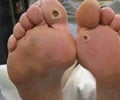miR200 protein could be a potential target for therapeutic interventions and also a possible biomarker for early detection of complications in type 1 diabetes.

For the study, induced pluripotent stem (iPS) cells, which have the potential to differentiate into any type of cell in the body, were used to model the disease. These iPS cells were derived from skin cells obtained from patients who have had type 1 diabetes for 50 years or more and are members of the Joslin 50-Year Medalist Program, and also from healthy controls.
Study participants were classified according to complications status- Medalist +C for severe complications and Medalist -C for absent or mild complications. Dr. Kulkarni said, "Genetic analysis of the iPS and skin cells showed remarkable differences in expression of genes and proteins in the Medalist +C group compared to the Medalist -C group and the controls. The analysis revealed higher levels of a protein known as miR200 in the Medalist +C group than in the Medalist -C group and controls. This was a very significant finding because miR200 plays an important role in the DNA repair process."
When the research team reduced expression of miR200 in iPS and skin cells from the Medalist +C group, the DNA damage checkpoint pathway machinery was restored and DNA damage was reduced in the cells. This makes miR200 a promising potential target for therapeutic interventions and also a possible biomarker for early detection of the development of complications in type 1 diabetes.
The study is published in Cell Metabolism.
Source-ANI















